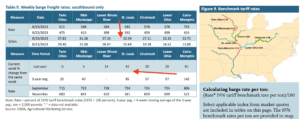Congress has quickly engaged in putting together potential aid packages for farmers that would more than double the Trump administration's $12 billion under the Farmer Bridge Assistance (FBA) Program.
Mississippi River Barge Freight Rates Climb on Lower Water Levels
Bloomberg writer Tarso Veloso Ribeiro reported yesterday that, “The cost to transport America’s harvest from the Midwest to the rest of the world is soaring as shrinking water levels on the Mississippi River drive up barge freight rates — and the forecast for below-than-average rainfall offers no relief.
7-Day Total Precipitation Outlook, Sept. 1st - 8th. pic.twitter.com/xZk3qWmfGw
— FarmPolicy (@FarmPolicy) August 31, 2023
“Barge spot rates as of Aug. 29 in St. Louis are up 49% from last week and 42% from last year at $23.34 a ton. That’s up 85% from the past 3-year average, according to data from the Department of Agriculture released Wednesday.”

Ribeiro explained that, “The data comes just as the US prepares to begin its soybean and corn harvest, signaling another tough year for US farmers who already are struggling with drought and fierce competition from Brazil and Russia.
Mississippi River at St. Louis pic.twitter.com/bmp10oDl4B
— FarmPolicy (@FarmPolicy) August 31, 2023
“Last year, extremely low water levels on the Mississippi River stranded more than 2,000 barges, crippling commerce on the vital waterway.”
Mississippi River at Memphis pic.twitter.com/4Jo5ci177s
— FarmPolicy (@FarmPolicy) August 31, 2023
The Bloomberg article added that, “Water levels on the Mississippi River, which carries more than 45% of US agricultural exports, have been dropping since June, restricting the amount of grain allowed on each barge.
Mississippi River at Rosedale pic.twitter.com/LtCkjgVAmr
— FarmPolicy (@FarmPolicy) August 31, 2023
“This led to a tightening of barge supply as more barges are required to transport the same amount of grain.”
Also yesterday, Dow Jones writer Kirk Maltais reported that, “Lower water levels on the Mississippi River since June are limiting the amount of grain that can be loaded on barges heading to ports, said the USDA in its weekly Grain Transportation Report. The USDA says that water levels are expected to keep falling in the coming weeks, which in turn will further limit the amount of grains barges can carry and thusly constricting the available amount of barges. ‘The tight supply has resulted in a significant increase in barge spot rates,’ said the USDA.”

With respect to the Illinois River barge freight rate, yesterday’s Grain Transportation Report also pointed out that, “For the week ending August 29: 47 percent higher than the previous week; and 14 percent higher than last year; and 38 percent higher than the 3-year average.”
Ohio River at Cairo pic.twitter.com/084UUHah34
— FarmPolicy (@FarmPolicy) August 31, 2023
Dow Jones News also reported yesterday that, “Export sales of U.S. corn and soybeans have surged for the 2023/24 marketing year, while sales for the current 2022/23 marketing year are mostly negative.
“The Department of Agriculture reported in its weekly export sales report Thursday that sales of corn in 2023/24 for the week ended Aug. 24 totaled 991,800 metric tons, and soybeans totaled 1.12 million tons. Meanwhile, net corn sales for 2022/23 were a net reduction of 71,700 tons, while net 2022/23 soybean sales were a net reduction of 50,700 tons.”
“Meanwhile, wheat sales totaled 329,100 tons for the 2023/24 marketing year, driven by sales to China,” the article said.
Also yesterday, Reuters writer Michelle Nichols reported that, “United Nations Secretary-General António Guterres said on Thursday that he had sent Russian Foreign Minister Sergei Lavrov ‘a set of concrete proposals‘ aimed at reviving a deal that allowed the safe export of Ukrainian grain via the Black Sea.”
Two vessels are sailing through a temporary corridor from Ukraine's Black Sea ports to the Bosphorus.
— Oleksandr Kubrakov (@OlKubrakov) September 1, 2023
The bulk carriers ANNA-THERESA (Liberia) and OCEAN COURTESY (Marshala Islands) have left the port of Pivdennyi and are moving along the established corridor. They are carrying… pic.twitter.com/oRtTlbQ3CU
And Alice Hancock reported yesterday at The Financial Times Online that, “The EU’s agriculture chief has proposed that the EU should subsidise the cost of transiting Ukrainian grain through the bloc after Russia pulled out of an initiative to allow exports through the Black Sea.
“Ukraine’s grain has been largely stuck in silos since Russia ended the Black Sea agreement in July. The EU in May imposed an export ban on Ukrainian grain into bordering EU countries, preventing the cheaper food from flooding local markets.”
The FT article noted that, “Janusz Wojciechowski, EU agriculture commissioner, today told MEPs he was pushing for the bloc to fund companies that would transit the grain before the EU’s export ban is lifted on September 15, adding that the idea was supported by Ukraine and the five frontier member states.”





